Ancient Greek Sculpture
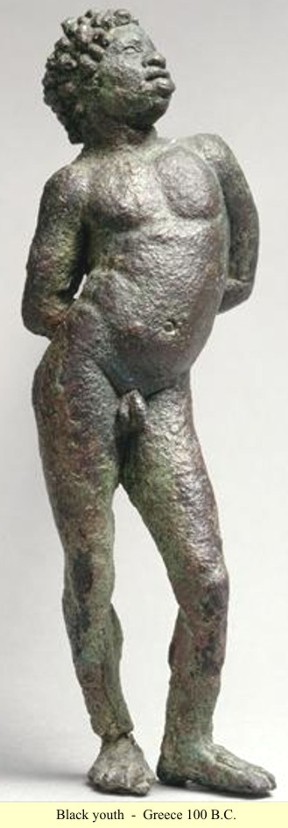 | 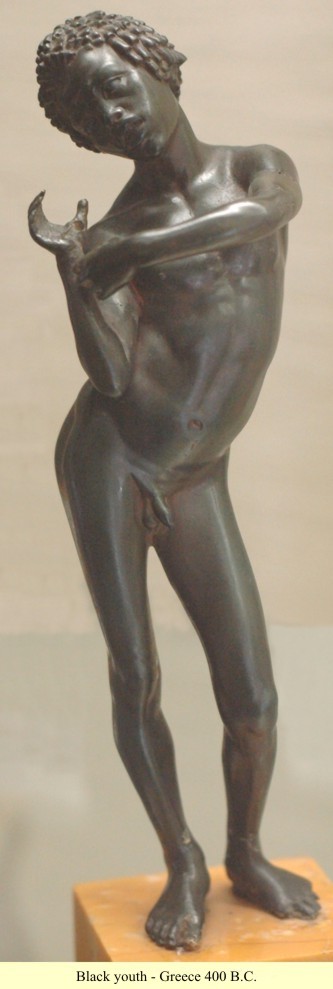 | 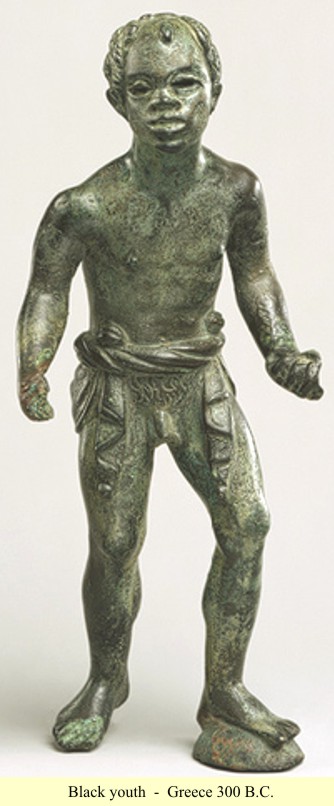 |
Please note, the statues above demonstrate their authenticity by either showing paint residue or "Natural" aging.
Ancient Greek sculptureMostly marble and bronze were used in Greek sculpture. Although it was initially thought that Greek statues were mostly unadorned white marble, by the early 19th century the systematic excavation of ancient Greek sites brought forth a plethora of sculptures with traces of multicolored surfaces. Some of these traces are still visible to the naked eye even today, though in most examples the remaining color has faded or disappeared entirely once the statues were exposed to light and air. In spite of this overwhelming evidence for painted statues, influential art historians such as Johann Joachim Winckelmann so strongly opposed the idea of painted Greek sculpture that proponents of painted statues were dismissed as eccentrics and their views largely dismissed for several centuries.It wasn't until published findings by German archaeologist Vinzenz Brinkmann in the late 20th century and early 21st century that painted Greek sculptures became an established undeniable fact. Using high intensity lamps, ultraviolet light, special cameras, plaster casts and certain powdered minerals, Brinkmann was able to scientifically prove that the entire Parthenon, including the actual structure as well as the statues, was in fact painted. He furthermore was able to reveal the pigments of the original paint and has created several painted replicas of Greek statues that are currently on tour throughout the world. Also in the collection, are replicas of works from other Greek and Roman sculptures showing that the practice of painting sculpture was widespread and in fact the normative practice rather than the exception in Greek and Roman culture. Museums to host the exhibit include the Glyptothek Museum in Munich, the Vatican Museum, and the National Archaeological Museum in Athens among others. The collection made its United States debut at Harvard University in the Fall of 2007. |
 |
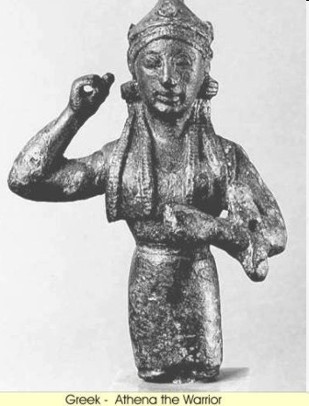 | 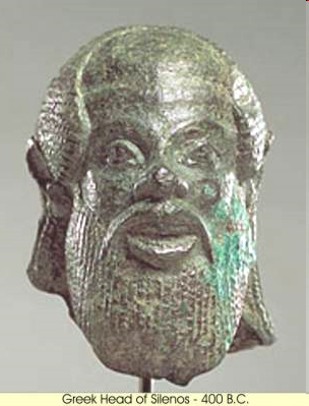 |  |
 |
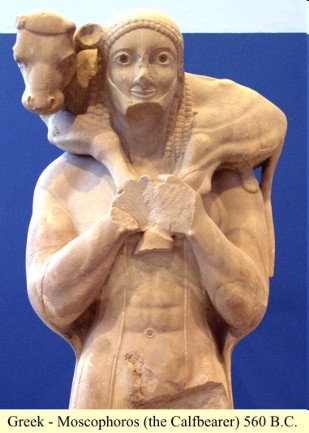 | 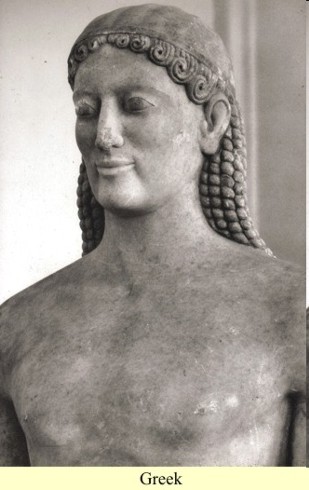 |  |
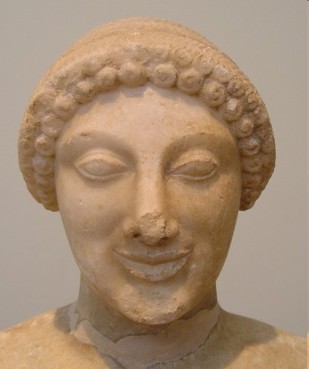 |  |  |
 | 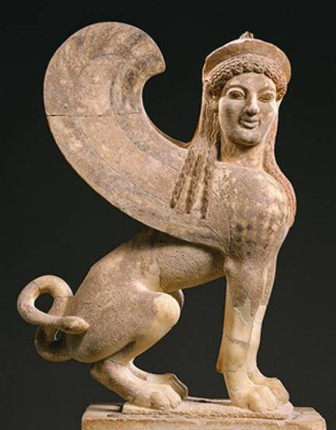 |  |
 |
Modern Greek Sculpture
(mostly of the 18th. and 19th. century's)
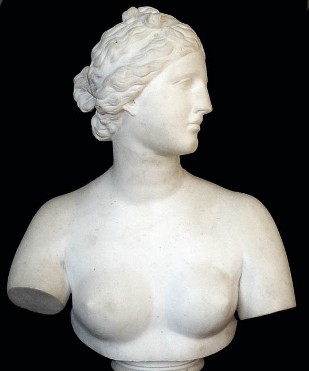 | 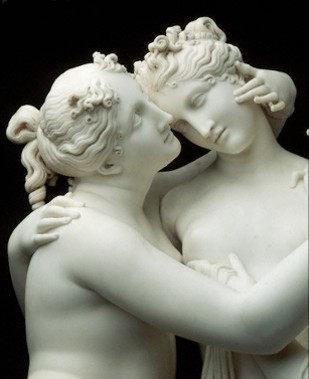 |  |
Just making the point that the ancient Greeks were not as taught, and quite different from the modern people. The modern image of ancient Greece, is derived from sculpture made long after the ancient Greeks were no more. |
 |
| Click here for images of all the peoples of the ancient Persian, and then Greek Empires: Click >>> |
Alexander the Great
Out of the fray of wars, emerges Alexander of Macedon. Alexander the Great's father Philip, was the brother of King Perdiccas III of Macedon, which is in northern Greece. In 359 B.C, King Perdiccas died. His young son Amyntas was expected to succeed him, with his uncle Philip as his regent, but Philip usurped his nephew's throne, making himself King Philip II. He proved to be a strong ruler, and in a few decades he conquered most of Greece.
Philip's wife was Olympias, daughter of King "Neoptolemus I" of Epirus, in modern Albania. Their son Alexander was born in 356 B.C. Alexander also had a younger sister, Cleopatra (not the famous Greek queen of Egypt). Alexander and his father, did not get along well at all, Philip often made fun of him because he had a high voice. When Philip was stabbed and killed by his male lover, Alexander ascended to the throne. In 330 B.C, Alexander defeated the Persian Empire and made that Empire his own.
With the end of the Persian Achaemenian Empire, southern Mesopotamia and Persia were partitioned by Alexander into the satrapy of Babylonia in the south, while the northern part of Mesopotamia was joined with Syria into another satrapy. It is not known how long this division lasted, but by the death of Alexander the Great in 323 B.C, northern Mesopotamia was removed from Syria and made a separate satrapy. One of his generals, Seleucus (later Seleucus I Nicator), received the satrapy of Babylonia to rule. Seleucus thus became the ruler of a large empire, stretching from modern Afghanistan to the Mediterranean Sea. Interestingly, even as late as 148 B.C, the Greek pantheon of Gods was still of Black Gods.
 |
The wealth, culture and technology, that is acquired from the conquered civilizations, will be absorbed by the Greeks to form, what is commonly called the "classical Greek culture". This culture will later be absorbed by the next great European civilization, The Romans.
 |  |
The classical period conventionally ends at the death of Alexander the Great in 323 B.C, and the fragmentation of his empire, which was divided among the "Diadochi" his successors: they were the rival generals, family and friends of Alexander the Great. This marks the beginning of the Hellenistic period.
Roman Greece came into being, following the Roman victory over the Macedonian's by the Roman general Quintus Caecilius Metellus, who defeated Andriscus of Macedon, the last Ancient King of Macedon in 148 B.C. Then the Corinthians were defeated at the Battle of Corinth in 146 B.C. However, some Greek poleis managed to maintain a partial independence and avoid taxation. The Aegean islands were added to this territory in 133 B.C. Athens and other Greek cities revolted in 88 B.C, but the peninsula was crushed by the Roman general Sulla. The Roman civil wars devastated the land even further, until Augustus organized the peninsula as the province of Achaea in 27 B.C, after which, Greek history and Roman history become intertwined.
The next wave of Whites from Central Asia
The Germanic's
also Slav's
At about 100 A.D. a new people from Central Asia began to encroach on Roman territory, these were the Germanic's. Here is what "Cornelius Tacitus" (who was likely a Celt, 56 - 117 A.D.) had to say about them: He was a senator, and a historian of the Roman Empire: We quote from his book, The Germania (Latin: De Origine et situ Germanorum, literally Concerning the Origin and Situation of the Germanics).
Cornelius Tacitus, Germany and its TribesThe Germans themselves I should regard as aboriginal, and not mixed at all with other races through immigration or intercourse. For, in former times, it was not by land but on shipboard that those who sought to emigrate would arrive; and the boundless and, so to speak, hostile ocean beyond us (the north Sea), is seldom entered by a sail from our world. And, beside the perils of rough and unknown seas, who would leave Asia, or Africa, or Italy for Germany, with its wild country, its inclement skies, its sullen manners and aspect, unless indeed it were his home? In their ancient songs, their only way of remembering or recording the past, they celebrate an earth-born god, Tuisco, and his son Mannus, as the origin of their race, as their founders.The name Germany, on the other hand, they say, is modern and newly introduced, from the fact that the tribes which first crossed the Rhine and drove out the Gauls, and are now called Tungrians, were then called Germans. Thus what was the name of a tribe, and not of a race, gradually prevailed, till all called themselves by this self-invented name of Germans, which the conquerors had first employed to inspire terror. For my own part, I agree with those who think that the tribes of Germany are free from all taint of inter-marriages with foreign nations, and that they appear as a distinct, unmixed race, like none but themselves. Hence, too, the same physical peculiarities throughout so vast a population. All have fierce blue eyes, red hair, (classic Albinism), huge frames, fit only for a sudden exertion. They are less able to bear laborious work. Heat and thirst they cannot in the least endure; to cold and hunger their climate and their soil inure them. |
Decline of the Roman Empire

When Constantine became the sole Roman Emperor in 324 A.D, Christianity became the leading religion of the empire. After the death of Constantine in 337, two of his sons, Constantius II and Constans took over the leadership of the empire. Constans, ruler of the western provinces, was like his father, a Christian. In 341, he decreed that all pre-Christian Graeco Roman worship and sacrifice should cease; warning those who still persisted in practising ancient Graeco-Roman polytheism with the threat of the death penalty.
Lay Christians took advantage of new anti-Graeco-Roman polytheism laws by destroying and plundering the temples. Temples that survived were converted into Christian churches: the Pantheon is the most notable example, having once been a temple to all the gods and later, removing the statues of the so-called 'pagan' gods and replacing them with Christian saints, becoming a church in honor of their own one god. Many of the buildings in the Roman Forum were similarly converted, preserving the structures if not their original intent.Later on, the emperor Julian the Apostate attempted to reverse the process of Christianization and bring back the native forms of polytheism, but his death in Persia caused the empire to once again fall under the power of Christian control, this time permanently.
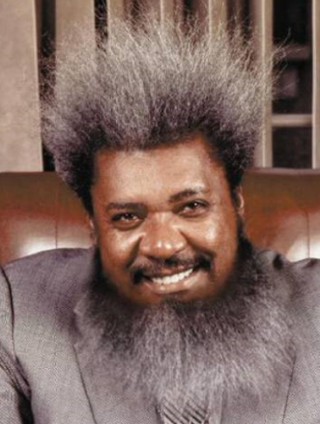
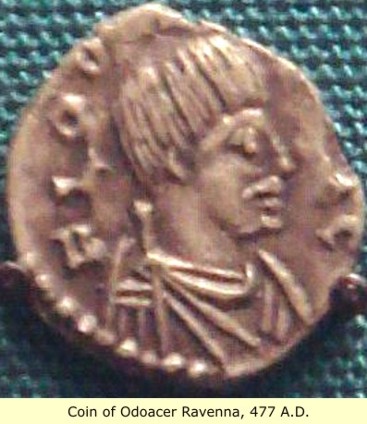
The decline of the Roman Empire was a slow process, which occurred over a period of over 350 years. Beginning at about 100 A.D. and culminating on September 4, 476, when Romulus Augustus, the last Emperor of the Western Roman Empire, was deposed by Odoacer, a Germanic chieftain.
Though by appearance, Odoacer was probably a Celt/Gaul: they being the original people of Germany. With the actual true (White) Germaic's following. Note that Odoacers hair stands straight up, White peoples hair cannot do that naturally. (Laugh at the example if you will, but the point still holds true, also note Vercingetorix's hair).
Charlemagne
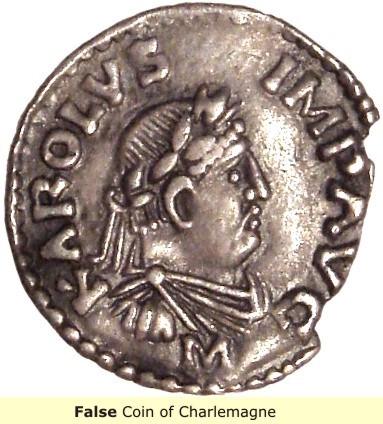
Rome's replacement "The Holy Roman Empire" was a realm that existed for about a millennium in West and Central Europe: ruled by a Holy Roman Emperor. Charlemagne (meaning Charles the Great; possibly 742 – 28 January 814 - King of the Franks). He expanded the Frankish kingdom (France) into an empire that incorporated much of Western and Central Europe. During his reign, he conquered Italy and was crowned Imperator Augustus by Pope Leo III on 25 December 800 A.D. This temporarily made him a rival of the Byzantine Emperor in Constantinople. His rule is also associated with the Carolingian Renaissance, a revival of art, religion, and culture through the medium of the Catholic Church. Through his foreign conquests and internal reforms, Charlemagne helped define both Western Europe and the Middle Ages.
He is numbered as Charles I in the regnal lists of Germany (where he is known as Karl der Große), the Holy Roman Empire, and France. He was crowned Emperor of the Romans in 800 A.D. and was then the forerunner of the Holy Roman Emperors, largely because he had inaugurated the tradition of imperial coronation by the Pope of the Catholic Church. This continued as a significant institution in the Holy Roman Empire until the 16th century. In a decree following the 1512 Diet of Cologne, the name was officially changed to Holy Roman Empire of the German Nation. Charlemagne's policy of "renovatio Romanorum imperii" (reviving the Roman Empire) remained at least in theory, as the official position of the Empire until its end in 1806.
Was Charlemagne a Black man? At this point there is no way to know - and that information is not likely to be forthcoming. But it appears that contrary to what Whites say, the Franks were probably a "Native" NOT Germanic people. As such, Charlemagne would have indeed, probably been a Black man. But because Whites have so interwoven European history with lies, there are really no safe assumptions, and no safe place to start.
As to the false Coin: In 1861, Charlemagne's tomb was opened by scientists who reconstructed his skeleton and estimated it to be measured 74.9 inches (190 centimeters). A modern study based on the dimensions of his tibia estimate his height as 1.84 m. This puts him in the 99th percentile of tall people of his period given that average male height of his time was 1.69 m. The width of the bone suggest he was gracile not robust in body build. So at least one thing we know for sure: that COIN image is NOT of Charlemagne. But what's new, Whites routinely use fake artifacts to bolster their lies. Charlemagne was actively and personally involved in wars into distant lands throughout his 46 year reign - Fat guys don't get around like that! So whoever decided to falsely use that coin, didn't even know the history of the man.
But there is no ambiguity about Charlemagne's successor as Holy Roman Emperor: Otto I, he was most certainly a Black man!
Holy Roman Emperor: Otto I
 |
Note: Otto I is the Black Freising King on the "Coat of Arms" of the current Pope: Pope Benedict XVI, who is of German extraction.
 |
 Otto I, the Great (23 November 912 in Wallhausen – 7 May 973 in Memleben), son of Henry I the Fowler and Matilda of Ringelheim, was Duke of Saxony, King of Germany, King of Italy, and "the first of the Germans to be called the emperor of Italy" according to Arnulf of Milan. While Charlemagne had been crowned emperor in 800, his empire had been divided amongst his grandsons, and following the assassination of Berengar of Friuli in 924, the imperial title had lain vacant for nearly forty years. Otto succeeded his father as king of the Saxons in 936, on February 2, 962, Otto was crowned Emperor of what would later become the Holy Roman Empire.
Otto I, the Great (23 November 912 in Wallhausen – 7 May 973 in Memleben), son of Henry I the Fowler and Matilda of Ringelheim, was Duke of Saxony, King of Germany, King of Italy, and "the first of the Germans to be called the emperor of Italy" according to Arnulf of Milan. While Charlemagne had been crowned emperor in 800, his empire had been divided amongst his grandsons, and following the assassination of Berengar of Friuli in 924, the imperial title had lain vacant for nearly forty years. Otto succeeded his father as king of the Saxons in 936, on February 2, 962, Otto was crowned Emperor of what would later become the Holy Roman Empire.| Click Here for more on Black British Royalty: Click >>> |
In order to seal an alliance between two Saxon kingdoms, her half-brother, King Athelstan of England, sent two of his sisters to Germany, instructing the Duke of Saxony (later Otto I, Holy Roman Emperor) to choose whichever one pleased him best. Otto chose Edith and married her in 929. The remaining sister Algiva or Adiva was married to a "king near the Jupiter mountains" (the Alps). The precise identity of this sister is debated. She may have been Eadgifu of England, who married King Charles III of France, or another sister otherwise unknown to history.
As queen, Eadgyth undertook the usual state duties of a Queen: when she turns up in the records it is generally in connection with gifts to the state's favoured monasteries or memorials to female holy women and saints. In this respect she seems to have been more diligent than her now widowed and subsequently sainted mother-in-law Queen Matilda whose own charitable activities only achieve a single recorded mention from the period of Eadgyth's time as queen. There was probably rivalry between the Benedictine Monastery of St Maurice founded at Magdeburg by Otto and Eadgyth in 937, a year after coming to the throne and Matilda's foundation at Quedlinburg Abbey, intended by her as a memorial to her husband, the late King Henry I. Like her brother, Athelstan, Edith was devoted to the cult of Saint Oswald and was instrumental in introducing this cult into Germany after her marriage to the emperor. Her lasting influence may have caused certain monasteries and churches in Saxony to be dedicated to this saint.
Eadgyth died at a relatively young age. Her tomb is located in the Cathedral of Magdeburg, Germany. A lead coffin inside a stone sarcophagus with her name on it was found and opened in 2008 by archaeologists during work on the building. An inscription recorded that it was the body of Eadgyth, reburied in 1510. It was examined in 2009, then brought to Bristol, England, for tests in 2010. Professor Mark Horton of Bristol University said that "this may prove to be the oldest complete remains of an English royal."
Edith and Otto's children were: 1. Liutgarde, married Conrad the Red, 2. Liudolf, Duke of Swabia (930-September 6 957)
| Click Here for medieval Christian frescos from northern Greece: Click >>> |
 From the words of Cornelius Tacitus, and others: Herodotus, Xenophanes, it is clear that the ancient Romans and Greeks did NOT look like the White, Blue-eyed, Red haired Germaic's. And of course from modern studies, we know that aside from being Germaic, the modern populations also have significant Turk admixture. But just WHO were these White Germanic invaders? From the words of Cornelius Tacitus, and others: Herodotus, Xenophanes, it is clear that the ancient Romans and Greeks did NOT look like the White, Blue-eyed, Red haired Germaic's. And of course from modern studies, we know that aside from being Germaic, the modern populations also have significant Turk admixture. But just WHO were these White Germanic invaders?Major Germanic Peoples: English, Norwegians, Danes/Denmark, Franks/France, Goths/Spain, Saxons, Finni, Flemish, Icelanders, Frisians, Gall, Batavians, Calucones, Dutch, Helisii, Ingvaeones (North Sea Germans), Irminones (Elbe Germans), Istvaeones (Rhine-Weser Germans), Jutes, Juthungi, Lombards or Langobardes, Ostrogoths, Teutons, Vagoth, Vandals, Vangiones, Vargiones, Varini, Varisci, Vinoviloth, Viruni, Visburgi, Visigoths, Vispi.(Pretty much all of Modern Europe, isn't it). |
The European Dark Ages
The "Dark Ages" is a term referring to the perceived period of both cultural and economic deterioration as well as disruption that took place in Western Europe following the decline of the Roman Empire: the phrase was first recorded in 1602. Originally, the term characterized the bulk of the Middle Ages as a period of intellectual darkness between the extinguishing of the light of Rome, and the Renaissance or rebirth from the 14th century onwards.
The concept of a Dark Age originated with the Italian scholar Petrarch (Francesco Petrarca) in the 1330s, and was originally intended as a sweeping criticism of the character of Late Latin literature. Petrarch regarded the post-Roman centuries as "dark" compared to the light of classical antiquity. Later historians expanded the term to refer to the transitional period between Roman times and the High Middle Ages, including not only the lack of Latin literature, but also a lack of contemporary written history, general demographic decline, limited building activity and material cultural achievements in general. Popular culture has further expanded on the term as a vehicle to depict the Middle Ages as a time of backwardness, extending its pejorative use and expanding its scope.
The Problem!
Just as the Hellenes and Romans were an illiterate nomadic people, when they first entered Black Europe over a thousand years earlier. And just as they struggled to learn the ways and technologies of civilization, so it was also for the Germanic's. And just as before, there was a "Dark Ages" of regression, while they learned the ways of civilization.
But unlike the Hellenes, the Germanic's did NOT attribute their inheritance of civilization to the rightful benefactor (albeit an unwilling benefactor), the Black ancients. They perhaps ignorantly, perhaps racistly, attributed it to the Classical Greeks. Though somewhat eclipsed by technology today, the sense of a legacy was strongly felt by post-Renaissance European elite, who saw themselves as the spiritual heirs of Greece. As late as 1939 Will Durant could write "excepting machinery, there is hardly anything secular in our culture that does not come from Greece," and conversely "there is nothing in Greek civilization that doesn't illuminate our own".
Had it remained just a sense of debt to the ancient Greeks, the world would have been a much better place today. But it did not, the Germanic's not having any history of their own, decided to make one up, with the Hellenes and Romans as the base. They decided that they were the descendants of the Hellenes and Romans, but since they were White skinned, Blue-eyed, Blond haired, and the Hellenes and Romans were not. They decided to create statues and other artifacts depicting Hellenes and Romans as such.
Then, perhaps as a "Snowballing" effect, they decided that ALL ancient civilizations must be White like them also: soon White Egyptian artifacts began to appear (exclusive of the legitimate Greek and Roman period type). Then ancient Europeans, Mesopotamian's, Hebrews, and Persians became White. Then with their success in wars of expansion and colonization, they decided that because they were so great, then everyone previous of any consequence must also have been White - and the requisite artifacts thus appeared. (All this from a people who just a few hundred years earlier, couldn't figure out why it was a bad idea to shit in the same places that you took your drinking water from).
The Turks
The next, and final wave of White Asians, the Turks, continued their migrations into Europe, North Africa, and Western Asia, well into the modern era. And just like the previous Whites, they were bent on conquest. And just like the Germanic's, having no history, they decided to create a place in history for themselves. Thus they became the descendants of the Berbers, Egyptians, Mesopotamian's, Persians, Phoenicians, and Arabs - and oh yes, the Hebrews, vis-à-vis the Khazar Turks.
Interestingly though, Turks in Turkey proper, are taught something quite different. In the Turkish Nations creation myth (a modern country with a creation myth?). From tomes: a large or scholarly book, produced by the Ministry of Education in 1932; Turks are taught that at the dawn of history, their ancestors, led by a mythical gray she-wolf, started migrating outwards from the heart of Central Asia. As the numbers of their people swelled and droughts dried the traditional grazing lands on the steppe, some of them, they are told, even crossed the Bering Strait into the Americas. Presumably becoming the American Indians. In his later years, Mustafa Kemal Ataturk (the founder of the modern Turkey nation), himself adopted a creed known as the "Sun Theory", which depicts the Turks as the mother race of all mankind, and proposed that all human languages are descendants of one proto-Turkic primal language. (Note: though the theory may sound outlandish, there is justification, and anecdotal evidence, for believing that at least the "North American Indian" was a Turk mulatto).
Mustafa Kemal Ataturk, taught that the Turks discovered the America's fifty years before Christopher Columbus. The proof of this assertion, he told journalist, was that the Turks and Caicos Islands in the Caribbean, had obviously been named by Turks, especially since their capital was called Grand Turk. (The islands are in fact named after a fez-shaped cactus).
All-in-all, it seems fair to say that Whites have done a great job of screwing-up, not only history, but the Planet and it's people.

No comments:
Post a Comment